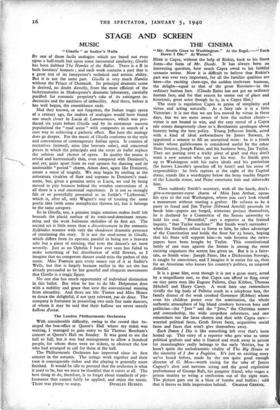STAGE AND SCREEN
MUSIC
"Giselle " at Sadler's Wells
By one of those facile analogies which are based not even upon a half-truth but upon some inessential similarity, Giselle has been dubbed The Hamlet of the Ballet. There is a B in both heroines' bonnets ; and each work contains a part that is a great test of its interpreter's technical and artistic ability. But it is not the same part. Giselle is very much Hamlet without the Prince of Denmark. Its principal dramatic scene is derived, no doubt directly, from the most efficient of the lachrymatories in Shakespeare's dramatic laboratory, carefully purified for romantic propriety's sake of its astringent in- decencies and the nastiness of imbecility. And there, before it has well begun, the resemblance ends.
Had they known, or not forgotten, the Italian tragic opera of a century ago, the makers of analogies would have found one much closer in Lucia di Lammermoor, which was pro- duced six years before Giselle and by its enormous success popularised the "mad scene" with composers in search of a sure way to achieving a pathetic effect. But here the analogy does go deeper. For the music of Giselle conforms to the style and conventions of contemporary Italian opera. It consists of recitatives (mimed), arias (the bravura solos), and concerted pieces in which the principals and the corps de ballet replace the soloists and chorus of opera. In quality the music is trivial and harmonically thin, even compared With Donizetti's, and yet, quite apart from its real aptness for dancing and its undeniable " period " charm, Adam does, again like Donizetti, create a sense of tragedy. We may begin by smiling at the coloratura rivalries of flute and soprano in Donizetti's mad- scene, but, given a genuine artist as Lucia, we end by being moved to pity because behind the wooden conventions of it all there is a real emotional experience. It is not so strongly felt or so powerfully presented as in Isolde's " Liebestod," which is, after all, only Wagner's way of treating the same poetic idea (with some metaphysics thrown in), but it belongs to the same category.
So in Giselle, too, a genuine tragic emotion makes itself felt beneath the placid surface of its tonic-and-dominant strum- ming and the weak Italianate melodies of its first act. The second act is little more than a divertissement in the romantic Sylphides manner with only the slenderest dramatic pretence of continuing the story. It is not the mad-scene in Giselle, which differs from its operatic parallel in being not a bravura solo but a piece of miming, that tests the dancer's art most severely. Just as no Ophelia I have ever seen has failed to make something of her distribution of wild flowers, so I imagine that no competent dancer could miss the pathos of this scene. Miss Fonteyn gets every ounce out of it at Sadler's Wells, but that is largely because earlier in the act she has already persuaded us by her graceful and eloquent movements that Giselle is a tragic figure.
No one else has much opportunity of individual distinction in this ballet. But what he has to do Mr. Helpmann does with a nobility and grace that save the conventional miming from absurdity. And there are Mr. Turner and Miss Honer to dance the delightful, if not very relevant, pas de deux. The company is fortunate in possessing two such fine male dancers, of whom it may be said that their ballons are never merely ballons d'essai.
The London Philharmonic Orchestra With considerable difficulty, owing to the crowd that be- sieged the box-office at Queen's Hall where my ticket was waiting, I managed to gain entry to Sir Thomas Beecham's concert at Queen's Hall on Sunday. It was good to see the hall so full, but it was bad management to allow a hundred people, for whom there were no tickets, to obstruct the few who had arranged to call for them at the hall.
The Philharmonic Orchestra has improved since its first concert in the autumn. The strings work together and their tone is consequently richer and the playing is generally more finished. It would be idle to pretend that the orchestra is what it used to be, but we must be thankful that it exists at all. The best thing to do, therefore, is to forget about standards of per- formance that cannot fairly be applied, and enjoy the music.


































 Previous page
Previous page